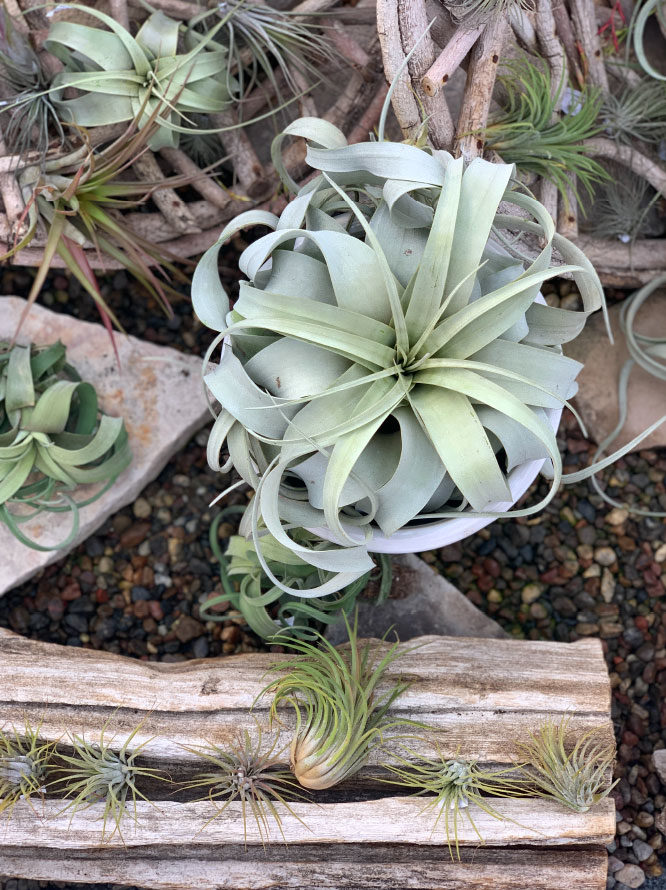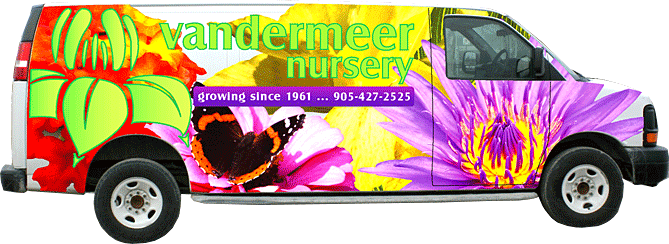HOUSEPLANTS
AIR PLANTS 101
What is an Air Plant?
“Air plant” is the common name for members of the Tillandsia genus and they thrive without needing to be planted in soil! Air plants are considered epiphytic by nature, meaning they grow on objects or other plants for support, rather than getting support from roots in the ground. That being said, they are not parasitic and do no harm to their host plant.
Being epiphytic means plant processes run a little bit differently than with most other plants - water, nutrients, support, and other necessary elements for life are collected in unique ways. While Tillandsia aren’t rooted in soil, they still have roots! These aerial roots are used to anchor the plant to a wall, tree trunk, branches or other supporting structure, plus they can retrieve water available from the surface they are attached to. The other method of gathering water is through modified leaves that can absorb significant amounts from rainfall and humidity from the air. Some types of air plants use one method or the other, while others use both! In terms of nutrients or food, some minerals are contained in the rainwater that is collected, and others are pulled from decaying organic matter that collects on the plants.

These unique plants may seem a little intimidating, but they can be easy to grow once you understand their preferences. Plus, they’re a ton of fun to style with! We hope the following tips and tricks will take the mystery out of air plants and give you many years of enjoyment with your new air-plant babies.
Light
Air plants do best in bright, filtered light through the months of April to October. For indirect light, your plant should be able to see as much of the sky as possible, without seeing the sun. This is typically a space within 2-5 feet of a large window. Too much direct sun in the spring and summer months can cause burning of the leaves! From November to March, unfiltered, bright light (direct sun) is appreciated as we experience lower daylight levels and time. They can also be grown under artificial light, but full spectrum (fluorescent) light is a must. The plants will require 10-12 hours of light per day, and need to be placed within 3 feet of the light source. Regular incandescent bulbs don’t emit the quality of light these plants need to photosynthesize.
Water
Although they do not require soil, these plants still need water to survive! There are two different ways to water your Tillandsia at home: misting and soaking. The frequency of each is dependent on your climate. If it is a dry environment, mist the plant once per day, and immerse it in water at least once a week for 30 minutes or more. If the environment is humid, the plant will take longer to dry out but will still require frequent care... Misting may be needed every couple of days, depending on humidity, while soaking should occur approximately every two weeks.
In both watering methods, you should be using room temperature water and, if possible, rain water. If you do not have access to rain water, then you can leave your water out for at least 24 hours to let the chlorine evaporate. Whatever you do, do not use distilled water as it is too pure and will actually pull nutrients out of the plant causing tissue death.
The key to successful soaking is to water your air plants in the morning, which gives your plants plenty of light to help with the drying process before nighttime! If the plant does not dry out completely within 4 hours, it will not be able to “breathe” properly and the plant can develop rot over time. After watering, shake off any excess water and place air plants upside down for at least 30 minutes (or more if your plant is larger and has more places for water to get trapped) until dry. If your plant is in bloom, be careful not to submerge the flower or bud while you’re soaking!
For best success, remember that these directions are just a guideline and you should pay close attention to the firmness and texture of the foliage! If the plant feels overly soft, it means you’re giving it too much water. If it starts getting dry and crispy, you are not watering enough. Brown tips on leaf ends, wrinkles and leaves that start becoming concave are signs that your air plant is in desperate need of water!
Temperature & Air Movement
Air plants are tropical and prefer warmer temperatures! In our climate, they are best to be kept indoors but can be placed outdoors in the summer months so long as they are not exposed to direct sunlight. Air plants thrive in temperatures ranging from 15°C to 32°C. Be sure to place your plant where air circulation is sufficient, as Tillandsia do not like closed, stuffy conditions.
Fertilizer
Since air plants are not in soil they are not getting regularly supplied nutrients beyond what is in their water! Fertilizing regularly during the growing season is recommended if you are looking for faster growth. However, air plants are sensitive to zinc, boron and copper and these ingredients are found in most commercial fertilizer for houseplants. To avoid these particular nutrients, we recommend using a fertilizer that is specifically designed for air plants or bromeliads. Just follow the manufacturer's instructions for application! Do not fertilize during the fall and winter months when the plant will be dormant, unless you are seeing active growth. If you are seeing active growth in the winter, use a one-time application of half-strength fertilizer to support that growth.
Flowering
A Tillandsia life cycle consists of each plant growing to maturity and blooming, so if you have been giving your air plant proper care, eventually you will be rewarded with a flower! Flowers vary in colour but tend to be shades of purple, red, and/or yellow, and depending on the species, can last anywhere from several days to many months. For most Tillandsia, blooming will occur naturally in late winter through mid-summer. Unfortunately, each plant will only flower once in its lifetime as they are monocarpic plants. This means that the “mother” plant will die after flowering. However, they will produce a set of ‘pups’ (plant babies) before they die, leaving you with one or more new plants to care for! Each plant can produce 2-8 pups per year. As the pups mature, they will start producing a bloom and pups of their own and the cycle continues! Once the original mother plant starts to die off, you can remove the dead foliage. Just be sure to not force it, as it should come off easily once it is entirely dead.
Styling & Display
Now this is the fun part! Tillandsia can be grown basically anywhere: mounted on rocks, in a seashell or on coral, or attached to driftwood, cork, or grapevine to name a few. They could also be housed in a ceramic or decorative pot as long as gravel, pebbles, or any other medium that drains rapidly is used, or even in a glass terrarium that gets sufficient air circulation. The only thing to avoid is copper wire or containers as it can kill your air plant. Just don’t forget that you have to be able to water it and it has to be able to dry thoroughly after watering. The sky’s the limit!




